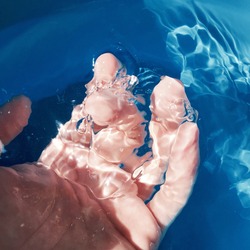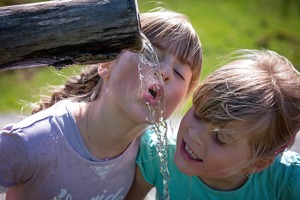This is about the importance of clean water to sustain health and life; how we as Americans assume (often mistakenly) that we will always have it; and an extraordinary young man named Seth Maxwell who founded Thirst Project, which is dedicated to the simple but powerful idea that clean water is everyone’s right. We take many things for granted as Americans. One of them is clean water. To drink. To cook. To bathe. To wash things. Clean water will always be there for us…at least that’s what we think. But many Americans are learning the hard way that what we take for granted can be taken from us. For example, the drought in California. The water shortage it has caused is nothing short of frightening. Not enough water to grow crops, or put out fires. Not enough water to pipe to communities. If the drought is not resolved soon–and no one thinks it will be–then California families will find other places to live. They will conclude that, without water, it is just not safe to live in California anymore. And so the state that everyone once wanted to live in will be a state that many will want to leave. For their own safety. Another example are the water supplies throughout the United States that today are badly contaminated by years of industrial chemical dumping. These are millennia-old aquifers flowing underground, which, for as long as there have been humans on the planet, have supplied them life-giving water. But, over the last 100 years, polluting companies have badly damaged these aquifers by dumping millions of gallons of toxins and allowing them to seep ever deeper into the ground until they render the water in the aquifer unusable. Some of these aquifers can be cleaned up–but it will take decades, typically. Some aquifers, for all practical purposes, will never be cleaned up. I have worked as a lawyer for many hundreds of families who were devastated to learn that their aquifer had been taken from them by chemical contamination. They had to find another way to try to get clean water. It is a horrible betrayal of what they thought it meant to be an American. Yet, for all the unsettling news about our access to clean water here, we are in dramatically better shape than much of the rest of the world. Beyond the United States, there are an estimated 1 billion people who do not have access to clean water. 1 billion people. The number is almost too large to even comprehend. Yet, unlike Americans, many of these 1 billion are not shocked or angry to know that they have no clean water. Sadly, they never had clean water in the first place. They grew up with no expectation that clean water would be there for them….let alone a belief that clean water was their right. And so they drink and cook with and bathe in water that is not fit for humans. Because it is all that they have. The consequences are as predictable as they are devastating: for these people, water is not the source of healing and nourishment, as it was intended to be; instead, it is the reason people get sick and die–especially, children. Children die by the thousands around the world each day for the shockingly simple reason that there was no clean water–or no water at all–for them to drink. Thirst Project was founded by a man named Seth Maxwell and 7 of his college friends. They are young people armed with determination, energy, brains, and an unflinching passion which recognizes that people everywhere–not just in America–have the right to clean water. Their noble and ambitious goal is to “eradicate the global water crisis.” They do it by mobilizing young people–mostly high school and college-aged–to raise money and awareness, all aimed at building freshwater wells in developing countries and communities. As a result of their efforts, the Thirst Project is the world’s leading youth water activism organization. One of their projects has focused on Swaziland, a country whose 1.25 million population is ravaged by a lack of access to clean water, which contributes significantly, for example, to the fact the life expectancy is only 48-years-old, and the mortality rate of children under age five is a shocking 80/1000. In 2012, Maxwell and his Thirst Project partners embarked on a mission to raise $50 million to supply the entire country with clean water. The entire country. Which will make a profound difference and save, literally, tens of thousands of lives. Thirst Project is doing its good work through projects in many other countries as well, such as India, Uganda, Ethiopia, El Salvador, Kenya, and Columbia. I invite you to read and learn more about Maxwell and his Thirst Project and to find a way to join them in their important work. Because once we say–as we must–that everyone else in the world has the same human right to clean water that Americans do, and once we recognize–as we must–the terrible price that is paid when that right is violated, then we realize that there is work to do…and it’s all of our jobs to do it.
Related Posts: What Should You Do if Your Groundwater is Contaminated?, Clean Water Isn’t a Right if You Never Had It, Congratulations to McHenry County, IL, for Disclosing its Groundwater Contamination Problems, Which Chemicals are Most Likely to Contaminate Groundwater?
 Fifty percent of Americans depend on groundwater for daily use in their homes, i.e., drinking, showering, etc. Unfortunately, the quality and safety of our groundwater is under increasing threat from a variety of man-made sources, with potentially grave risk to the health of those in our family who may be exposed to the contamination. Please take a moment to consider whether you live near any of these common sources of groundwater contamination:
Fifty percent of Americans depend on groundwater for daily use in their homes, i.e., drinking, showering, etc. Unfortunately, the quality and safety of our groundwater is under increasing threat from a variety of man-made sources, with potentially grave risk to the health of those in our family who may be exposed to the contamination. Please take a moment to consider whether you live near any of these common sources of groundwater contamination: Illinois Personal Injury Lawyer Blog
Illinois Personal Injury Lawyer Blog




